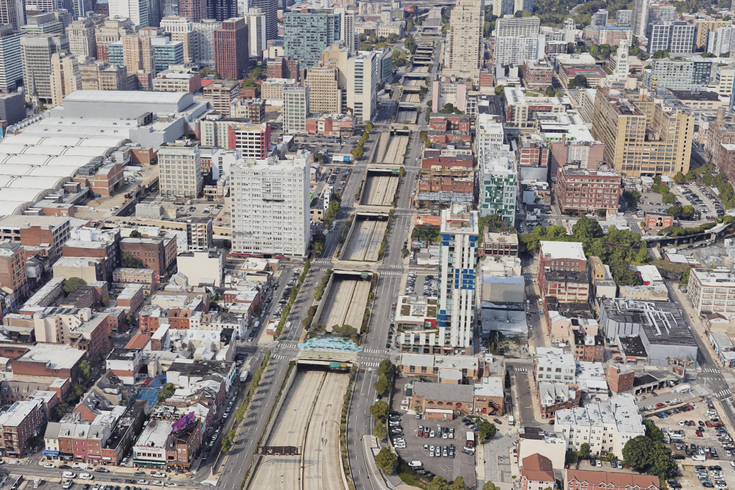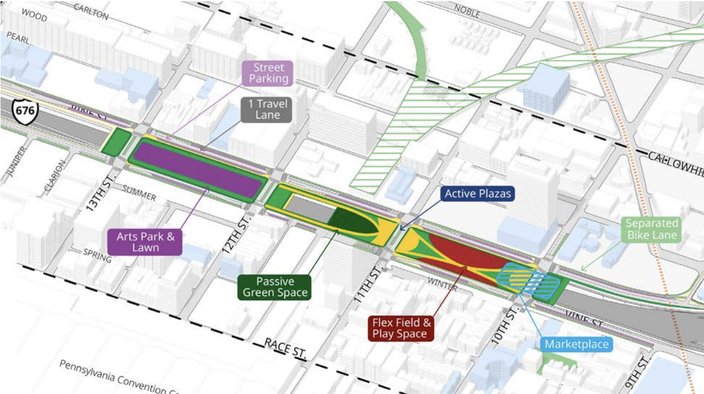
December 20, 2023
 StreetView/Google Maps
StreetView/Google Maps
Philadelphia officials preferred design for the Chinatown Stitch project is to build two caps above the Vine Street Expressway. The first cap would span 10th Street to a midway point between 11th and 12th streets. A second cap would later be built between 12th and 13th streets.
The city's preferred design for the Chinatown Stitch project is to construct a pair of caps above the Vine Street Expressway. The two proposed spans would reconnect the north and south sections of the neighborhood that were split by the highway's construction in the 1960s, creating a physical barrier and quality of life issues for residents.
The city's estimated cost of the project is $160 million
Formally known as I-676, the busy, east-west, highway cuts a trench that runs 1 3/4 miles through Chinatown between Ninth and 12th streets. Chinatown residents have long advocated for the idea of capping the highway, and the cap initiative finally gained momentum earlier this year when the city received federal and private funding to examine its feasibility.
After conducting highway analysis and community engagement, city officials said on Tuesday that the best solution will be to construct two separate caps above the Vine Street Expressway. This would create about 2 1/2 blocks at street level, making space for parks and new buildings in Chinatown.
The first cap would span the full block between 10th Street and a point midway between 11th and 12th streets. A second cap would later be built between 12th and 13th streets. The plan also would redesign roads on the local sections of Vine Street, which rank among the city's most dangerous roadways.
“The Vine Street Expressway remains a visible scar in our Chinatown neighborhood — and city at-large — as significant portions of the neighborhood were demolished and residents displaced for its construction,” said Mike Carroll, deputy managing director for the city’s Office of Transportation, Infrastructure, and Sustainability. “The project is known as the Chinatown Stitch because it will sew the disconnected parts of Chinatown together with an inviting green space and safe street design, prioritizing the needs of the elderly, young, and those with disabilities.”
The selected design is one of three considered during the past several months. One of the city's priorities for Chinatown Stitch is that it connects existing green spaces in the neighborhood, like the Rail Park and Franklin Square. The goal also is to improve pedestrian and bicycle safety in the areas surrounding I-676.
The two other plans that had been discussed each called for variations of a single, three-block cap running from 10th to 13th streets. Although these plans received support from the community, there were technical barriers related to highway safety regulations — including the need for ventilation in the event of a fire. With the two-cap plan, the opening between them from 11th Street to 12th Street would be framed by greenery along the north and south sides to provide continuity to the new neighborhood space.
Building two caps will allow for the project to be constructed in phases, block-by-block, city officials said in a report published Tuesday. While this plan would take longer to complete, it also would enable more time to secure federal construction funding. The city anticipates that most of the project would be covered by grants from the federal infrastructure law that was passed two years ago.
A diagram shows the proposed design of the two caps that would run between 10th and 13th streets, with a gap in between them.
The $4 million planning phase of the project is being supported by the federal Reconnecting Communities Pilot program, which specifically seeks to address problems created by the construction of highways. The city, PennDOT and private donors are contributing $2.2 million to the planning of the Chinatown Stitch.
The $160 million price tag includes $35 million for improvements to Vine Street. The project also includes construction of a pedestrian bridge at Ninth Street and another bridge connecting the second cap with a future section of the Rail Park along the Reading Railroad Viaduct.
The next step for Chinatown Stitch will be the preliminary design and engineering phase, which will take as long as two years. The city anticipates that construction could begin as soon as 2027, with a projected timeline of 4-5 years to complete both of the planned caps.
Cap projects are technically challenging endeavors that require extensive engineering to preserve the integrity of the roadways on which they're built. PennDOT's most recent inspection reports on the bridge structures that support the Vine Street Expressway found that they are all in good to satisfactory condition, officials said.
These projects have become appealing to city planners over the last few decades as a way to make better use of areas that have become public voids. Planners for Chinatown Stitch are looking at similar projects in Boston, Pittsburgh, Atlanta and other places to help guide their strategy for the Vine Street Expressway.
At Penn's Landing, PennDOT recently began work on the $329 million project to replace and expand the covered section of I-95 that runs along the Delaware River waterfront. That cap will become a 11 1/2-acre park that extends over I-95 and Columbus Boulevard, spanning from Chestnut to Walnut streets.
Planning for the Chinatown Stitch comes as the Philadelphia 76ers continue to pursue building a new arena on Market Street, between 10th and 11th streets, at the southern edge of Chinatown. The arena project has been met with resistance in Chinatown, where residents previously have fought off other large development projects and have questioned the team about how the proposal will benefit the community. The city is expected to soon release a series of impact studies it has been conducting on the 76ers arena plan since the summer.
Leaders in Chinatown praised the city's progress on the Chinatown Stitch project after the preferred design was announced.
“The Chinatown Stitch is an amazing reconnecting project where residents, immigrant business owners, and local and state officials are writing a new chapter in Chinatown's history to undo the harm of I-676," said John Chin, executive director of the Philadelphia Chinatown Development Corp.
 Source/City of Philadelphia
Source/City of Philadelphia